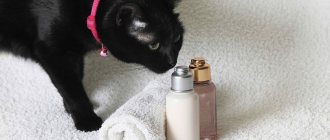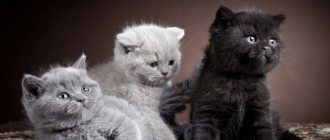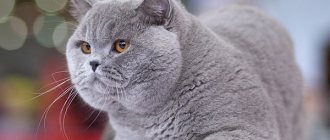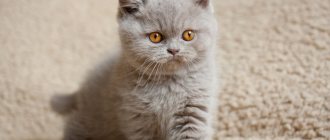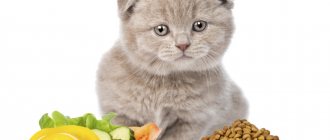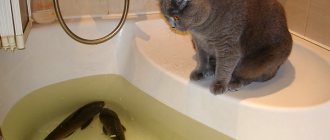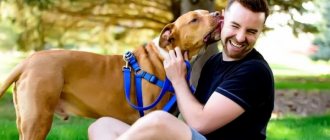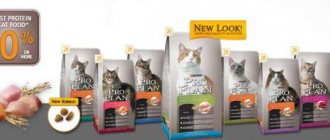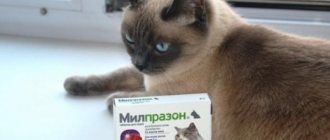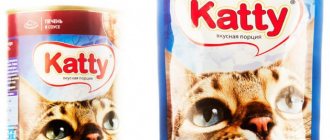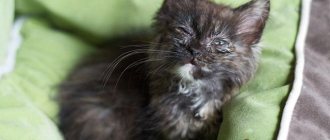History of British cats (Origin)
In the muddy British climate, the typical “British” wool is a real salvation. It is she, with her powerful undercoat, that can perfectly protect from rain and piercing wind. This breed gained fame at the end of the 19th century.
The first world cat exhibition took place on July 13, 1871. It was organized by the famous artist Harrison Weir. He came up with the idea of breed standards, called “points of superiority.” According to it, a cat is judged by the number of points that a certain part of its body deserves. At this stage, the system became known as “breed standards.” In 1889, the first purebred British cat was recognized; it was a white female.
It is worth noting that until the 30s of the last century, at exhibitions these cats were only called “short-haired”. That's how they were announced. But at the same time, the British, who truly understood the value of this breed and sought to achieve its development. For this purpose, massive individuals were selected, with a heavy “frame” and a large, rounded head, with very noticeable cheeks and a small nose. This appearance is ideally matched by huge round eyes, which are set quite wide and of medium size, as well as ears with characteristically rounded tips.
And, of course, in the time of Harrison Weir there were completely different British people who are very different from the current strong guys of this breed. Many changes have occurred in coat colors, and some of them can even be called revolutionary.
The Persian breed also took part in the formation of the short-haired “British”, but the Chartreau Blue Carthusian cat, perhaps, had the greatest influence. Breeders in continental Europe for a long time did not consider mating with Carthusians experimental. This explains such a beautifully built large body with short powerful legs and a non-standard head.
And, if, according to the rules, the head of the “British” is large and round, with full, developed cheeks that organically fit into the proportions of the head, then in this case the animal’s head is only slightly rounded, it is characterized by a smoothed forehead and a pinched muzzle. And, despite the fact that the cheeks are quite thick, they alone will not be able to create the impression of a real “British” head. It will look more like an inverted trapezoid with a rounding, which is typical for Chartreaux.
To this day, the British breed is actively developing in the world. The animal's head becomes larger, its eyes become more expressive, and the cat itself becomes more powerful. Thus, the current “British” are large, but rather compact representatives of the cat, with a solid mass of muscles, strong and healthy. Typically rounded head with saucer eyes set far apart. A developed chin and prominent cheeks, a wide nose, and modest ears. Characteristic features are excellent build, endurance, power and wisdom, combined with the wonderful appearance of a teddy bear.
The fawn and cinnamon colors, previously unknown, are becoming increasingly popular. “British” are handsome people who have a friendly disposition and self-esteem, are not pretentious in their care, and know how to communicate well with children and pets who live in the same house as them. Of course, thanks to this, the breed has become one of the most popular on the planet, and here too.
The peculiarity of these cats is their original coat, which distinguishes them from other breeds. Its length is quite short, but not as much as that of the Orientals. Due to the thick undercoat, it looks dense, raised from the body, giving the cat a plush appearance. The fur of the “British” cats acquired such density over the course of a century, resulting in a simply ideal “fur coat” that allows the cat to feel comfortable in the damp English climate. The structure of the fur is not very soft, it is even springy. The thickness and density of the fur will not allow the snow to come into contact with the animal’s body.
Of course, various characteristics of the coat, such as quality and texture, may vary depending on what climate the cat lives in, what time of year it is, and even what color the animal is. The fur of kittens is softer, and this is taken into account when judging. But at the same time, the slightest fluffiness will be considered a serious flaw when it comes to an adult animal.
Therefore, all standards for this breed in any felinological system contain a very thorough description of the coat, and the performance of a particular animal is assessed quite strictly. 25-40 points are awarded for coat quality and color. That is, even if all the parameters of a representative of the breed are at their best, but the texture, length or density of the coat will have some inconsistencies, or the color will differ from the declared one, the cat will not be awarded the title and will not be allowed for breeding.
Standard and description of the British cat
The coat of the “British” is very fluffy and soft, although quite short. In principle, these cats come in a large number of colors. Solid colors are popular - black, chocolate, gray-blue, or simply blue, lilac, as well as tabby in silver tones, and its subspecies - marble, spot, stripe.
A color is considered solid when the cat's body is completely one uniform shade, and there is not a single dot on it. The most common of the single-color colors of the “British” is blue-gray.
The combination of black-red, cream-blue is called tortoiseshell. It values uniformity. But, since by making selection it is impossible to influence how the spots in the color will be distributed, then the requirements for “turtles” are not as strict as for a monochrome color.
If a small part of the dye is absorbed by the guard hair, the color becomes smoky. Such cats are considered to be contrastingly colored - their undercoat is lighter than the almost black tips. The darkest shade is on the paws, back and head, and the lightest on the ears, sides and collar. In general, the body has a black smoky tint, even turning into silver on the sides. The muzzle and legs are simply black. Huge round eyes are characterized by a copper tint.
Tabby. Tabby's classic is considered to be "marble". Clarity and contrast are essential for a tabby pattern. A characteristic pattern appears on the forehead, like the letter M. Lines extend from the back of the head to the back, covering the shoulders. There is a pattern of rings along the chest and neck. On the back, three lines running in the same direction are separated by a base shade. The pattern on the sides is clearly visible, and on the hips it is complete circles. The stomach is just stained. And along the legs there are rings of the main color. The outside of the hind legs is uniform in color, with markings.
Bicolors. There is a symbiosis of the main color and white, while the main color can be solid or tortoiseshell. A clear boundary between white and color is required. The painted part is no less than a third, or no more than half, white. Color is required for at least one ear, small spots are allowed on the back, allowed on the legs if the overall degree of color is met.
Color (Siamese). The general color is white, with colored paws, mask and tail. Due to temperature changes, wool may change color.
Powerful cheeks and cheekbones perfectly highlight the roundness of the head. From the side, the transition of the round forehead into a small but wide nose is clearly visible. Not noticeable, but noticeable. At a great distance, the round, modest ears sit low.
The eyes are also widely spaced. Typically bright orange. Blue eyes are found in point cats. Chinchillas have shades ranging from blue and lavender to emerald green.
The body is stocky, powerful shoulders and chest.
The tail is thick, wider at the base, of medium length, and the tip is rounded.
The texture of the coat is thin, and the short “coat” itself is thick and does not fit. Powerful undercoat. A major fault is considered to be excessive length, softness or tight fitting of the coat.
It is worth noting that there is no breed of “British Fold” - there is “British short (or long) hair” and “Scottish Fold”. The latter exists in a version with straight ears.
Advantages: these cats do not require much attention and can be left alone for a long time; this is an excellent option for owners who are often absent from home. These animals have good immunity.
Disadvantages: they are wayward, they can have their own opinions on various occasions, therefore they require education from early childhood. You can easily catch a cold from a draft.
Life expectancy: “British” people are considered long-livers, as they live up to 20 years.
Features of the appearance of the breed
Representatives of the British breed are distinguished by their stockiness and unusual plush fur. Pets come in medium and large sizes. They are beautifully built and have good muscles. The fur does not adhere to the body, which is why pets look like plush toys. At the same time, it has a uniform length; often the undercoat has a darker color than the main shade of the coat. The limbs are short but strong.
The British breed is characterized by a large head with pronounced cheekbones. The eyes of the pets are wide open, the nose is straight, the ears are quite short, because of this the muzzle looks more rounded.
The color of the British is not only blue. Although mostly people have pets of this shade. Cats may not be the same color; uneven coloring of the coat is also allowed. Each shade has several variations, for example, lilac is divided into three types: light, medium, dark.
The British breed inspired Lewis Carroll to create the Cheshire Cat. The character was based on the wide and slightly smug muzzle of the British.
In fact, according to the breed standard, at least thirty types of colors are known:
- black;
- white;
- creamy;
- chocolate;
- lilac;
- ginger;
- tortoiseshell;
- marble;
- chinchilla;
- brindle;
- mackerel;
- smoky;
- tabby;
- spotted.
British cat character
Connoisseurs of “British cats” are sure that these cats are the best home companions. Their greatest advantages are their intelligence and low demands.
When you first meet this cat, you may come across British reserve and coldness. But once you get to know each other well, you will find a devoted friend in her, only on the condition that you give your love in return.
The character of the “British” is quite calm and not harmful. They are not too affectionate, playful, but not hyperactive. Living in a family, they consider it their clan; they do not choose their owner.
This breed is very sociable, but at the same time they must have time and place for privacy, then they will feel absolutely happy. The nature of this cat does not allow her to climb into your arms; she will simply sit next to you so that you have the opportunity to pet her.
If you pick up a “British”, they will push the person with their paws and turn away. Kisses, especially, are not welcome. If the British Shorthair receives a lot of wrong attention, he may become angry and hide. The “British” will accept another cat into their family without any problems.
How to choose a British kitten
So, you decided to get a pet and your choice fell on a British breed kitten.
This is not surprising : the plush Brits are so cute! They are ideal for being family favorites.
To acquire real affectionate happiness, and not a bunch of troubles and disappointments, you need to be guided by the rules for choosing purebred kittens.
You need to know the rules like two times two , then unscrupulous sellers will not be able to deceive you, and doing this is easier than you think.
Care and maintenance
How to care for your fur
Since the “British” breed is called short-haired, it is not difficult to care for their coat. But even their short “fur coat” will be “appreciative” if it is brushed every week. It is especially important to do this during the molting period, which usually occurs in spring and summer. To remove dead hair, you can use a special glove or a fine-tooth comb.
Nowadays, a whole series of “All Sistem” products is suitable for caring for the coat of the “British”. When choosing shampoos and conditioners from it, you need to focus on the color of the animal. These products can even correct your pet's color, or make it brighter, or add texture to the coat.
Ear care
Ears should be examined weekly, but, according to reviews from the owners of “British” cats, there is no excess wax in cats of this breed - the ears are usually clean and do not require additional care.
Dental care
The cat needs solid food to remove plaque naturally and have a preventative effect against tartar. Dry food has abrasive properties, removing plaque from teeth. But if the cat is fed “naturally”, then from time to time it should be given solid food, for example, chicken necks.
Nutrition
It is worth remembering that you cannot mix natural food and ready-made food in the diet of one animal. For those who prefer to prepare natural food for their pet, it is worth keeping in mind that a balanced diet includes 4 main food groups:
- Fish and meat. The preferred meats are rabbit, turkey, chicken and beef. It is given raw, just scalded with boiling water and finely chopped. By-products are given in small quantities, but preferably boiled.
They give only boiled sea fish. No more than twice a week.
- For dairy products, cats are given yogurt and low-fat cottage cheese. Eggs can be given to your pet no more than twice a week.
- Oils and fats. The daily cat norm is 1⁄2 teaspoon of unrefined oil.
- Cereals and vegetables. This includes rice, buckwheat and oatmeal, carrots, cabbage, and bran. They are given to animals 2-3 times a day.
If a cat eats “natural” food, then vitamin supplements are required. Only they should not contain biotin, because... it can cause the fur to lengthen, and this is not at all desirable for the “British”.
It is better to choose “super-premium” dry food from trusted manufacturers. When choosing food, you need to focus on the physiological state of the cat - age, height, tendency to obesity, pregnancy, etc.)
Conclusions and recommendations
Having weighed all the pros and cons when deciding to keep a British cat at home, we can add:
- If you want to have a proud pet with royal habits , the British are the best choice
- If your family has children and other pets, then choosing a cat of the British breed will be correct; it will fit into this friendly team, albeit with its own rules for living together
- The Briton is suitable for both an apartment and a private house, his good health will withstand small temperature changes in the home, just don’t forget to organize a place for him to sleep on a sunbed, so to speak, his own territory
- When getting a British breed cat, albeit an unpretentious one, calculate your financial capabilities and the availability of free time for care, feeding, and providing quality veterinary care. For the normal and full development of a Briton, he needs a balanced diet in accordance with his age, timely vaccinations, and regular care.
If all simple conditions are met, your pet will not cause you any trouble and will be a wonderful friend for your children or even a family member.
British cats have gained popularity among people due to their fluffy, plush-like fur and unusual color. Outwardly, they seem to be sweet and kind, but you can soon discover a complex and contradictory personality.
These unpredictable animals can be playful, friendly, or, on the contrary, cold, showing indifference to the owner. This article will help you understand the character of British cats and understand their habits.
Content
Necessary conditions of detention
Pets living within four walls require physical exercise to maintain good psychological and physical shape. The cat should be involved in various games and outdoor activities every day. The most common and primitive game is a string with a candy wrapper at the end. There are many varieties of it - a “fishing rod”, a wave with feathers, etc., just to awaken the hunter’s interest. To diversify your pet’s leisure time, you need to buy or make various equipment for training and warming up. These can be boards or branches that are strong enough and processed appropriately. Climbing on them not only gives the cat great pleasure, but also provides excellent exercise. By the way, sleeping on one of the top shelves is every cat’s dream. If you build vertical stands for climbing, they can also serve as excellent scratching posts.
Kitty or cat?
Which field to choose is up to you to decide.
British cats and female cats grow up to be equally well-mannered, affectionate, and loving to their owners.
They save all their love and tenderness for kittens.
When choosing a sex, you need to know why you are buying a purebred animal. Just for yourself and your family, and you are going to castrate him, or in order to accept offspring from him.
- If you buy a cat , you need to be ready to give birth, feed, and then place the kittens.
- With a cat there is less hassle , but he will also require special attention.
Every month you will need to look for a “girlfriend” for him, otherwise problems with the cat’s behavior will arise, which can develop into bad habits.
How to raise a British kitten →
British cat diseases
From their ancestors, the short-haired “British” inherited stamina and good health. But breeders note difficulties with the presence of two blood types (A and B) in the breed. This will become a problem if your pet was planned for breeding. In principle, type B is quite rare; approximately 1% of pets in the United States are carriers of it. But in purebred cats it is higher. So, among the “British” this figure is 36% of the population.
A cat with blood type B and a cat with blood type A can produce kittens with both blood types. Moreover, kittens with blood type A, even those born relatively healthy, die within 1-3 days. This happens due to the production of antibodies produced by a cat with blood type B and a cat with blood type A, which interact. Once transmitted to kittens through milk, they begin to destroy the kitten's red blood cells.
So that cats can be tested at an early age, a special DNA test has been invented. Therefore, American breeders coped with this task to the best of their ability.
Among other things, this breed has a tendency to be overweight, and sometimes there are dental problems.
How to avoid being deceived
- Immediately drive away the idea that a real British kitten can be bought at a pet store, at the market, at randomly organized sales points or in dubious establishments such as shelters for abandoned animals.
- A real British dog should be purchased from breeders who specialize in this breed. Only then will the purchase make you happy.
- As a rule, it all starts with searching for advertisements for the sale of British kittens on the Internet or in the newspaper. Then you call up and ask how old the kittens are, if they have a pedigree, what vaccinations they have received, and what they already know how to do.
- Ideally, kittens should be about 3 months old (although feeding a two-month-old kitten is not a problem). By this time, they should have already received the necessary vaccinations recorded in the veterinary passport.
It will not be superfluous to ask whether the breeder has a certificate or other document confirming his professional skills and experience in breeding the British cat breed.
- Under no circumstances agree to have a kitten delivered to your home. Otherwise, buy a pig in a poke. Be sure to visit the nursery or apartment where the kittens were born and live with their mother cat.
- It is important to see that the babies are kept clean, fed properly and not locked in cages. Kittens should be loved, surrounded by the attention and care of their owners.
- Watch them . Pay attention to how they behave. The little ones should be playful, curious and not shy - they were not afraid of people, they were accustomed to being handled, they knew where the toilet and bowl were.
- When meeting in person with the British seller, ask to see the pedigree documents of the kitten’s parents. They must clearly indicate the British breed from generation to generation, without any impurities.
- Check out your baby's veterinary passport . Be curious about how the kitten tolerated the vaccinations and whether he had any painful conditions. What and when were his parents sick with? Could their illnesses have affected the kitten’s health? After all, you, more than anyone, are interested in ensuring that your future pet is healthy and makes you and your household happy.
Nurseries
"PLUSH GOLDEN KITTY" is a small home-type nursery. “British” breeds are even bred here in the rare golden color.
Moscow nursery BRIstyle. Pedigree breeding of the "British".
VIJUHA.com cattery is a large and friendly family of “British”.
In the ABSOLU nursery, in addition to the “British” ones, they also breed Scottish Folds. Specializes in incredibly beautiful colors.
Miracle Cats Cattery - here they breed “British” cats with patterned colors, without losing the characteristics of the breed.
Tinessa – breeding of “British” rare and classic colors in Yekaterinburg.
Cattery "RuStyle". In addition to the British, the Selkirk Rex breed is bred.
Scottish cattery "Camelia Cats" (Kamensk-Uralsky). This is the “home” of the Scottish Fold and Straight, as well as the Highland Fold and Highland Straight.
Price
The cost of a British Shorthair cat is small and depends on the class. Animals that are not suitable for breeding and exhibition are cheaper. Therefore, if your goal is to buy a pet, then feel free to choose a pet-class cat. Its cost will be about 100-150 dollars. Breed and show class cats are more expensive - about 500-700 dollars.
Be sure to purchase a cat from a trusted cattery. A low price may be a reason to doubt the integrity of the seller, so focus on the average price on the market.
